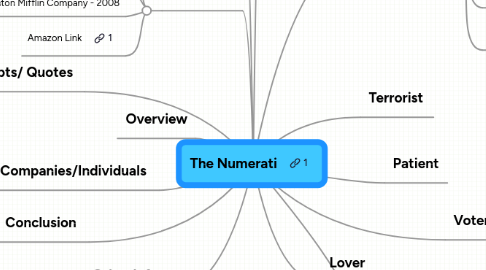
1. Book Info
1.1. The Numerati
1.2. by Stephen Baker
1.3. Houghton Mifflin Company - 2008
1.4. Amazon Link
2. Worker
2.1. Office workers historically less productive and not easily measured
2.2. MSFT patent in 2006 to measure worker vital signs
2.3. IBM
2.3.1. Samer Takrit
2.3.2. stochastic analysis
2.3.2.1. attempts to tie predictions to random events
2.3.3. modelling employee performance
2.3.3.1. big brother?
2.3.3.2. performance DNA
2.3.3.3. better match of skills to tasks
2.3.4. catalog everything (gestures, skills, etc.) - turn into numbers
2.3.5. challenge - create taxonomy to catalog skills of 300K IBM workers
2.3.6. Second Life
2.3.6.1. IBM created virtual world on SL in Nov. 2006
2.3.6.2. In the future, all business processes will be simulated
2.4. WARP
2.4.1. baseball wins above replacement player
2.4.2. compares cost variance of replacement player and the variance in wins to determine ROI
2.5. George Dantzig
2.5.1. created simplex algorithm
2.5.2. recipe to guide intelligent decision making
2.5.3. optimization
2.6. Chapter Quotes
2.6.1. Look at us one way and we are stocks. Change the perspective, and we're machine parts. p23
2.6.2. The work force is too big, the world too vast and complicated for managers to get a grip on their workers the old-fashioned way -- by talking to people who know people who know people. (p34)
3. Conclusion
4. Other Info
5. Companies/Individuals
5.1. Tacoda - Dan Morgan
5.2. IBM - Samer Takriti
6. Overview
7. Contributors to this Map
7.1. John Michl
8. Key Concepts/ Quotes
8.1. What kind of science gets it wrong 25% of the time?
8.2. While truth is vital in the world of machines, by nature it is approximate -- based on probability.
8.3. Truth, therefore, is not make-or-break-it for The Numerati. They triumph if they come up with better, quicker, or cheaper answers than the status quo. (p90)
8.4. KEY MORAL ISSUE
8.4.1. If a tool to predict if a person was a pedophile was accurate 85% of the time (and wrong 15%), should it be used?
9. Shopper
9.1. Semantic detail
9.1.1. contextual information
9.2. Chapter Quotes
9.2.1. In the online word, businesses no longer look at us as herds but as vast collections of individuals -- each of us represented by scores of equations. p42
9.2.2. Discouraging unwanted shoopers is far easier on the Internet p52
9.2.2.1. As merchants learn more about us...easier to determine who to reward and punish
9.3. Buckets
9.4. ** Spam vs. Medicine
9.4.1. David Heckerman - Microsoft
9.4.2. Created program to detect email spam
9.4.3. Spammers change message slightly to break through
9.4.4. If tool could detect mutations in spam, might also work in medicine
9.4.5. Shifted focus to HIV research
9.5. Consumer modelling
9.5.1. Initially used averages
9.5.2. Clustering software works better
10. Voter
10.1. Republican and Democrate fail to describe most of us
10.2. Monitor - What in the world were they thinking?
10.2.1. What does the future hold?
10.2.2. How will people fare in the future?
10.2.3. What skills and abilities will be needed to achieve success in the future?
10.3. Example of building campaign focused on five values
10.3.1. Extending opportunity to others
10.3.2. Working within a community
10.3.3. Achieving independence
10.3.4. Focusing on family
10.3.5. Defining righteousness
10.4. Voter groups
10.4.1. Barn Raisers
10.4.2. Right-click (technofriendly)
10.4.3. Hearth Keeper
10.4.4. Civic Sentries
10.4.5. Inner Compass
10.4.6. Crossing Guards
10.4.7. Still Waters
10.4.8. Bootstrapper (committed to individual initiative)
10.4.9. Stand Pats (long for a return to past values)
